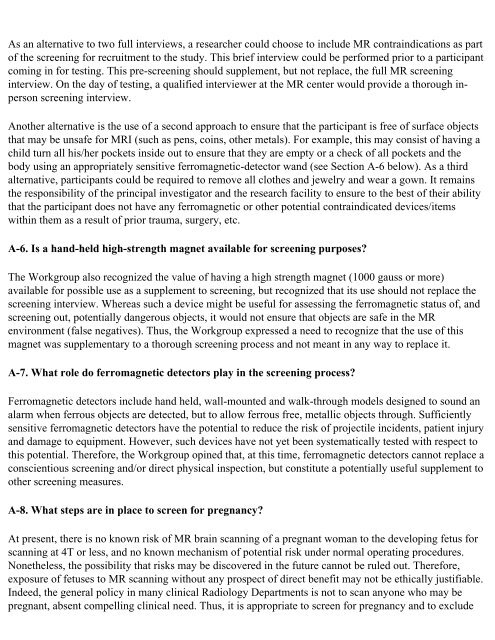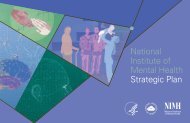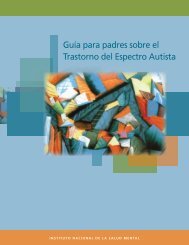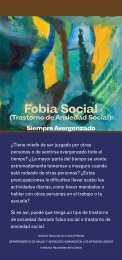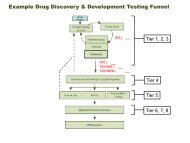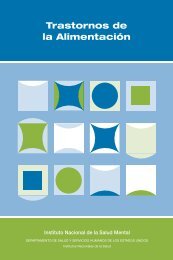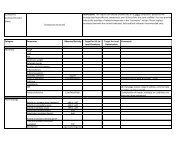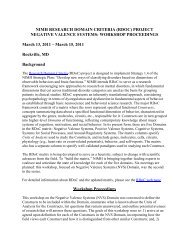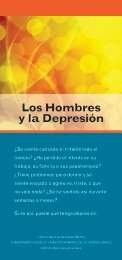MRI Research Safety and Ethics: Points to Consider - NIMH
MRI Research Safety and Ethics: Points to Consider - NIMH
MRI Research Safety and Ethics: Points to Consider - NIMH
You also want an ePaper? Increase the reach of your titles
YUMPU automatically turns print PDFs into web optimized ePapers that Google loves.
As an alternative <strong>to</strong> two full interviews, a researcher could choose <strong>to</strong> include MR contraindications as par<strong>to</strong>f the screening for recruitment <strong>to</strong> the study. This brief interview could be performed prior <strong>to</strong> a participantcoming in for testing. This pre-screening should supplement, but not replace, the full MR screeninginterview. On the day of testing, a qualified interviewer at the MR center would provide a thorough inpersonscreening interview.Another alternative is the use of a second approach <strong>to</strong> ensure that the participant is free of surface objectsthat may be unsafe for <strong>MRI</strong> (such as pens, coins, other metals). For example, this may consist of having achild turn all his/her pockets inside out <strong>to</strong> ensure that they are empty or a check of all pockets <strong>and</strong> thebody using an appropriately sensitive ferromagnetic-detec<strong>to</strong>r w<strong>and</strong> (see Section A-6 below). As a thirdalternative, participants could be required <strong>to</strong> remove all clothes <strong>and</strong> jewelry <strong>and</strong> wear a gown. It remainsthe responsibility of the principal investiga<strong>to</strong>r <strong>and</strong> the research facility <strong>to</strong> ensure <strong>to</strong> the best of their abilitythat the participant does not have any ferromagnetic or other potential contraindicated devices/itemswithin them as a result of prior trauma, surgery, etc.A-6. Is a h<strong>and</strong>-held high-strength magnet available for screening purposes?The Workgroup also recognized the value of having a high strength magnet (1000 gauss or more)available for possible use as a supplement <strong>to</strong> screening, but recognized that its use should not replace thescreening interview. Whereas such a device might be useful for assessing the ferromagnetic status of, <strong>and</strong>screening out, potentially dangerous objects, it would not ensure that objects are safe in the MRenvironment (false negatives). Thus, the Workgroup expressed a need <strong>to</strong> recognize that the use of thismagnet was supplementary <strong>to</strong> a thorough screening process <strong>and</strong> not meant in any way <strong>to</strong> replace it.A-7. What role do ferromagnetic detec<strong>to</strong>rs play in the screening process?Ferromagnetic detec<strong>to</strong>rs include h<strong>and</strong> held, wall-mounted <strong>and</strong> walk-through models designed <strong>to</strong> sound analarm when ferrous objects are detected, but <strong>to</strong> allow ferrous free, metallic objects through. Sufficientlysensitive ferromagnetic detec<strong>to</strong>rs have the potential <strong>to</strong> reduce the risk of projectile incidents, patient injury<strong>and</strong> damage <strong>to</strong> equipment. However, such devices have not yet been systematically tested with respect <strong>to</strong>this potential. Therefore, the Workgroup opined that, at this time, ferromagnetic detec<strong>to</strong>rs cannot replace aconscientious screening <strong>and</strong>/or direct physical inspection, but constitute a potentially useful supplement <strong>to</strong>other screening measures.A-8. What steps are in place <strong>to</strong> screen for pregnancy?At present, there is no known risk of MR brain scanning of a pregnant woman <strong>to</strong> the developing fetus forscanning at 4T or less, <strong>and</strong> no known mechanism of potential risk under normal operating procedures.Nonetheless, the possibility that risks may be discovered in the future cannot be ruled out. Therefore,exposure of fetuses <strong>to</strong> MR scanning without any prospect of direct benefit may not be ethically justifiable.Indeed, the general policy in many clinical Radiology Departments is not <strong>to</strong> scan anyone who may bepregnant, absent compelling clinical need. Thus, it is appropriate <strong>to</strong> screen for pregnancy <strong>and</strong> <strong>to</strong> exclude


